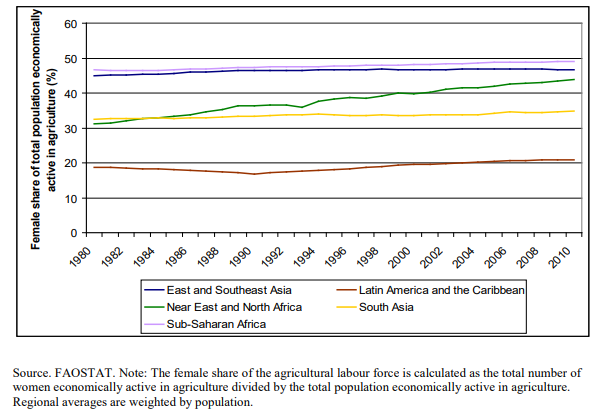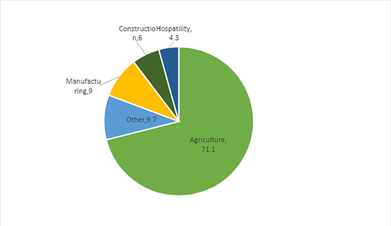

In developing countries like India, agriculture continues to absorb and employ female work force but fails to give them recognition of an employed or hired labour. Women constitute 38% of the agricultural labour force in developing nations. It is also estimated that 45.3% of the agricultural labour force consists of women only. Rural women work in farm, handle her responsibilities and also do her household activities. Among the household activities the primary job is of taking care of livestock or poultry farm. Livestock & poultry not only feed her family but also allows her to earn that extra income. Rural women on single hand perform the back breaking activity of cattle management in most parts of the country.
Cattle management involves cleaning of the shed & animals, watering the cattle, milking, fodder collection, making of farm manure etc. Women play a dominant role in livestock production and poultry. With the increase in rural men migrating to cities for better opportunities, women silently adorns many roles in the agriculture sector - from homemaker to labourer to cultivator and even entrepreneur , roles of rural women is changing very rapidly in Bharat. Women have started to predominate every level of agriculture and its value chain.
Indian Agriculture workforce is split under two heads:
- Cultivators (who own the land or have the right to operate on it) and
- Labourers (ones who do not own land but work on land owned by others in return of wages paid to them in cash or kind).
As per Census 2011, there were about 263 million agricultural workers in India and 37 per cent (or 98 million) of them were women. Between 1991 and 2011, more than 85 million agricultural workers entered the agriculture-workforce and 49 million (58 per cent) of these were women. In the two decades since 1991, while the number of male cultivators reduced by 3 million that of women cultivators jumped up by 14.2 million. There was an increase of 74 million agricultural labourers in these two decades, and about 47 per cent of these were women.
As per the National Sample Survey Office (NSSO), the percentage share of female workers was 60 percent in cattle, 40 per cent in goat and 60 per cent in poultry in 1983-84 and this increased to 70, 55 and 70 per cent respectively by 1999-2000. In states like Tamil Nadu, Manipur, Rajasthan, Andhra Pradesh, Karnataka, and Maharashtra, women accounted for more than half of their agriculture-labourers. Despite the rising and high share in the agriculture workforce, only 37 per cent of these women were cultivators (ones who owned land) and the remainder about 63 per cent worked as agriculture labourers (on farms owned by other).
In sociology, feminization is explained as a shift in gender roles and sex roles in a society, group, or organization towards a focus upon the feminine. It can also mean the incorporation of women into a group or a profession that was once dominated by men.
Agricultural feminization—which can be defined as the quantifiable increase of women in agricultural decision making and farm management—can happen in several ways.
As per Census 2011, out of total female main workers, 55 per cent were agricultural labourers and 24 per cent were cultivators. However, only 12.8 per cent of the operational holdings were owned by women, which reflect the gender disparity in ownership of landholdings in agriculture. Moreover, there is concentration of operational holdings (25.7 per cent) by women in the marginal and small holdings categories.
Women in agriculture are affected by issues of recognition and in the absence of land rights, female agricultural labourers, farm widows, and tenant farmers are left bereft of recognition as farmers, and the consequent entitlements.
Rural women perform numerous labour intensive jobs such as weeding, hoeing, grass cutting, picking, cotton stick collection, separation of seeds from fibre, keeping of livestock and its other associated activities like milking, milk processing, preparation of ghee, etc. Various activities taken up by women in Agriculture and its allied activities are:
- AGRICULTURE: rural women are engaged in agricultural activities in three different ways depending on the socio-economic status of their family and regional factors.
- Paid Labourers.
- Cultivator doing labour on their own land.
- Managers of certain aspects of agricultural production by way of labour supervision and the participation in post harvest operations
Type of agricultural activities taken up by women include:
- Sowing
- Nursery management
- Transplanting
- Weeding
- Irrigation
- Fertilizer application
- Plant protection
- Harvesting, winnowing, storing etc.
- Livestock: Livestock is the primary livelihood activity used to meet household food needs as well as supplement farm incomes. Cattle management activities include.
- Cleaning of animal and sheds
- Watering of cattle
- Milking the animals
- Fodder collection
- Preparing dung cakes
- Collection farm yard manure
- Poultry.
Economic Survey 2017-18 says that with growing rural to urban migration by men, there is ‘feminisation’ of agriculture sector, with increasing number of women in multiple roles as cultivators, entrepreneurs, and labourers
- Women account for 43% of the agricultural labour force in developing countries and slightly more than 30% in South Asia and India (FAO 2011). However, their access to productive resources (such as land aEnd livestock), inputs (fertilizers and improved seeds), and services (credit, extension) for agriculture reflects a “gender gap” that most often is rooted in social norms specific to a given geography and culture.
- It is in the same context that women carry out many responsibilities within households, in addition to agricultural labour (e.g., care giving of children and the elderly, fetching water and fuel, and tending to domestic chores) (FAO 2011). This disparity in access to productive resources, inputs, and services may result in women’s lower
- The Global Gender Gap Index (GGGI) developed by the World Economic Forum is a measure of the gap between women’s and men’s achievements in four broad outcomes: health, education, economic participation, and political empowerment (WEF 2014). The GGGI (and each of its sub indices) range from 0 (inequality) to 1 (equality). In 2014, India’s overall score was 0.64, and it ranked 114 out of a total of 142 countries.
Social inclusion refers to the removal of institutional barriers and the enhancement of incentives to increase the access of diverse individuals and groups to development opportunities. Empowerment, equal and meaningful participation in decision-making, access to and control over resources, benefit sharing, and balancing power relations are key areas for development
With women predominant at all levels-production, pre-harvest, post-harvest processing, packaging, marketing – of the agricultural value chain, to increase productivity in agriculture, it is imperative to adopt gender specific interventions. An ‘inclusive transformative agricultural policy’ should aim at gender-specific intervention to raise productivity of small farm holdings, integrate women as active agents in rural transformation, and engage men and women in extension services with gender expertise.
- Beti Bachao Beti Padhao (BBBP)
- Mahila Shakti Kendra (MSK) aims to empower rural women with opportunities for skill development and employment.
- Rashtriya Mahila Kosh (RMK) is an apex micro-finance organization that provides micro-credit at concessional terms to poor women for various livelihood and income generating activities.
- Swadhar and Short Stay Homes to provide relief and rehabilitation to destitute women and women in distress.
- Working Women Hostels for ensuring safe accommodation for working women away from their place of residence.
- Equal Remuneration Act, 1973 provides for payment of equal remuneration to men and women workers for the same work of similar nature without any discrimination. In order to ensure social security to the workers including women in the unorganised sector, the Government has enacted the Unorganised Workers’ Social Security Act 2008.
- The Sexual Harassment of Women at Workplace (Prevention, Prohibition and Redressal) Act, 2013 has been enacted, which covers all women, irrespective of their age or employment status and protect them against sexual harassment at all workplaces both in public and private sector, whether organised or unorganised.

- Helps in reducing gender disparity
- Will Aid in women empowerment and feminisation
- Helps in reaching SDG’s [It will enhance food and nutrition security and alleviate poverty and hunger. It’s strategy for achieving Sustainable Development Goals by 2030.]
- Will add more agricultural output
- Reduces migration as they do their own work
- Long hours of physical work may impact their health conditions, which may further create less productivity at home.
- Sum up to more mental stress as they had to take care of home and work at same time.
- Will be paid less compared then to men due to their less physiological strength required for work.
- May add up to disguise unemployment.
- The work done will not be paid if worked on own farm.
- Vulnerable at farm land as it mostly dominated by men
- Children will be affected as they will not paid attention after long hours of work at farm
- Less pay-scale for the work done is not satisfactory and thus push them to stay at homes.
The women labour force in agriculture and their contribution towards advancements of society are evident but the social dogma and long historical perception put their contribution under the scope of disparity and widened the gender divide, But the recent trends shows a growth by providing them a better opportunity in various sectors – which is best known as Women Empowerment and Empowerment through any means can leverage the true potential of any section of people..Thus attention and recognising women and their work will have a great impact and aid in achieving our targets focused on comprehensive growth of nation
Related Articles

